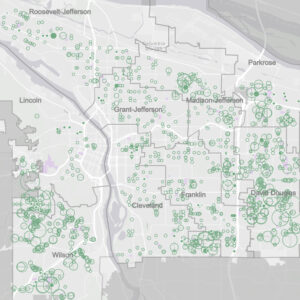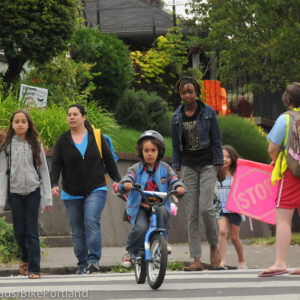
(Photo: Jonathan Maus)
The State of Oregon has opened up a new grant program to fund projects that make it easier to walk, bike, and roll to schools.
The Safe Routes to School Infrastructure Competitive Grant Program has a total of $16 million available statewide. The program is part of the $5.3 billion transportation package passed by the legislature in 2017. This is the first two-year cycle of the program and the funds available are set to increase to $30 million per year in 2021-22 and and 2023-24.
To give you some perspective on how far $16 million for schools will go in Oregon, the City of Portland recently announced they plan to spend $8 million on safe routes projects this summer alone.
ODOT also has a non-infrastructure grant program that can be used for things like education and planning. That program is funded at $500,000 per year through 2019 and will bump up to $1 million annually in 2020.
Advertisement
Cities, counties, tribes, and road and transit agencies that want to compete for these funds must submit a letter of intent by August 31st and complete an application by October 15th. They’ll also have to come up with a 20 or 40 percent cash match. Applicants from small cities with a project along a designated Priority Safety Corridor, or that have Title I status (where children from low-income families make up at least 40 percent of enrollment) will be eligible for the lower match amount.
Projects awarded funding in this first cycle will be built between 2019 and 2024.
Grab the application and learn more about the program on ODOT’s website.
— Jonathan Maus: (503) 706-8804, @jonathan_maus on Twitter and jonathan@bikeportland.org
Never miss a story. Sign-up for the daily BP Headlines email.
BikePortland needs your support.





I really wonder if the SRTS money wouldn’t be better spent simply closing the streets near schools to cars during the hours immediately before and after the school day starts and ends. At least the children will all get a tiny walk/bike in, and some of them might just get in the habit of doing the entire trip.
I say this because my heart simply breaks every time I pass by a school during the school year. I see long lines of cars to drop off little Johnny and Jane, but almost no children arriving under their own power. This situation isn’t helped by the staff’s behavior, since I rarely see any of them arrive under their own power either. We’ve got to start somewhere, and the babiest of steps seems to be to close the streets for a couple of blocks a few hours per day. The other SFTS programs have just seemed to be ineffective.
Can you explain more on why you think the comprehensive Safe Routes approach, developed over the past 10+ years, is ineffective? Just what you’re seeing personally? Is that at schools that are served by Safe Routes programs?
The City of Portland claims its Safe Routes programs have boosted walking/biking to schools by 35%.
https://www.portlandoregon.gov/transportation/68011
The National Center for Safe Routes to School found Safe Routes programs roughly doubled walking and biking to school, albeit to 16% and 2%, respectively.
https://www.cdc.gov/policy/hst/hi5/saferoutes/index.html
It’s worth noting that SRTS funding in the 2019-2020 cycle for Title 1 schools extends to projects within a 1-MILE RADIUS of the school (!). During HB2017, the Oregon Senate was attempting to limit funding to a quarter mile radius despite the House previously endorsing a 1 mile radius.
See the PDF on ODOT’s website for more information on qualifications.
https://oregon.gov/ODOT/Programs/TDD%20Documents/SRTS-Competitive-Program-FAQ.pdf
Frequently there are significant barriers to our children accessing the schools they attend in the form of ODOT facilities within the city. Cleveland and Franklin High are obvious given their proximity to Powell Blvd (OR-26), but less obvious ones include Title 1 recipients such as Lane Middle School where a sizable portion of the student body lives within Lents neighborhood and must negotiate crossing 82nd Ave (OR-213) daily or César Chávez School and Roosevelt High near Lombard in north Portland.
Safe crossings, as they exist today, can force children who live just on the other side of these facilities to have to reroute a quarter mile or further due to a sparing, infrequent application of safe crossings. It should be as easy and clear as possible for our children to walk to school safely. I am sure the collective minds of the city can formulate better routes via SRTS for future generations.
I’m excited to see these resources available to communities around the state! Through our education programs, The Street Trust gets a window on poor pedestrian and bike infrastructure around schools. That exposure drove our commitment to get funding to fix these deficiencies. and was our top legislative priority in 2017. Now we are watching the program closely to see how it works and how it can be expanded and improved. Thanks for helping spread the word!
Have a specific SR2S project that you want funded? Go bug your local state legislator to go bug your city council, Metro Councilor, city DOT, and (eventually) ODOT.